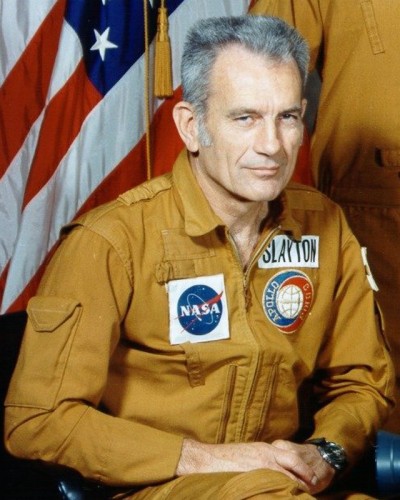DDekeoDekenDekeaDekelDekedDeke DekeSDekelDekeaDekeyDeketDekeoDekenDeke (Donald Kent Slayton)

In 1959, Donald Slayton was one of 110 military test pilots selected by their commanding officers as candidates for the newly formed National Aeronautics and Space Administration’s Project Mercury, the first U.S. manned space flight program. Following a gruelling series of physical and psychological tests, NASA selected Slayton to be one of the original group of seven Mercury astronauts. He was scheduled to fly in 1962 on the second orbital flight Mercury-Atlas 7, which he would have named Delta 7 (after the fourth letter in the Greek alphabet since this was the fourth manned Mercury flight, and “7” designating the seven astronauts), but because of an erratic heart rate (idiopathic atrial fibrillation), he was grounded in September 1962. MA-7 was flown by his backup, Scott Carpenter, who named the flight Aurora 7. Slayton was the only member of the Mercury Seven who did not fly in the Mercury program. When NASA grounded Donald Slayton, the Air Force followed suit. From September 1, 1962 until November 1963, he obtained the unofficial title of “chief astronaut” when he took on the position of Coordinator of Astronaut Activities, which would later officially become Chief of the Astronaut Office. Slayton resigned his Air Force commission in 1963 and then worked for NASA in a civilian capacity as head of astronaut selection. He had the decisive role in choosing the crews for the Gemini and Apollo programs, including the decision of who would be the first person on the Moon. In 1972, Slayton was awarded the Society of Experimental Test Pilots James H. Doolittle Award.
While grounded, Donald Slayton took several measures to attempt to be restored to flight status, including a daily exercise program, quitting cigarette smoking and coffee, and drastically reducing consumption of alcoholic beverages. He also took massive doses of vitamins, and for a time took daily doses of quinidine, a crystalline alkaloid. In July 1970 the fibrillation ceased, and a comprehensive review of his medical status by NASA’s director of life sciences and the Federal Aviation Agency resulted in the full restoration of his flight status in March 1972. Slayton celebrated with an hour of aerobatic maneuvers in a NASA T-38 jet trainer. After he was restored to flight status, Donald Slayton was selected in February 1973 as docking module pilot for the Apollo–Soyuz Test Project, a docking between an American Apollo spacecraft and a Soviet Soyuz spacecraft. The American crew immediately began an intensive two-year training program, which included learning the Russian language and making frequent trips to the USSR, where astronauts trained for weeks at Star City, the cosmonaut training center near Moscow. Slayton resigned as Director of Flight Crew Operations in February 1974. On July 17, 1975, the two craft joined up in orbit, and astronauts Slayton, Thomas P. Stafford and Vance D. Brand conducted crew transfers with cosmonauts Alexey Leonov and Valeri Kubasov. At the end of the flight, an erroneous switch setting led to the introduction of noxious fumes into the Apollo cabin during landing, and the crew was hospitalized as a precaution in Honolulu, Hawaii, for two weeks. During hospitalization, a lesion was discovered on Slayton’s lung and removed. It was determined to be benign. During his first and only spaceflight, he spent 217 hours in space.
After the Apollo–Soyuz flight, he became head of the Approach and Landing Tests (ALT) of NASA’s Space Shuttle. Following the ALT program, Donald Slayton served as Manager for Orbital Flight Test, directing orbital flight mission preparations and conducting mission operations. He was responsible for OFT operations scheduling, mission configuration control, preflight stack configuration control, as well as conducting planning reviews, mission readiness reviews, and postflight mission evaluations. He was also responsible for the Shuttle Carrier Aircraft program. Slayton was a friend of fellow astronaut Gus Grissom. He married Marjorie “Marge” Lunney (1921–1989) in May 1955, and they had one son, Kent Sherman, born April 8, 1957. They eventually divorced, and Slayton later married Bobbie Belle Jones (1945–2010) in 1983. They remained married until his death. His hobbies were hunting, fishing, shooting, and airplane racing. Shortly after he moved to League City, Texas, in 1992, Donald Slayton was diagnosed with a malignant brain tumor. He died from the illness, at the age of 69, on June 13, 1993.
Born
- March, 01, 1924
- USA
- Sparta, Wisconsin
Died
- June, 13, 1993
- USA
- League City, Texas
Cause of Death
- brain tumor
Other
- Cremated



